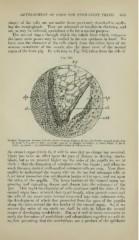Page 629 - My FlipBook
P. 629
DEVELOPMENT OF CORD FOR PERMANENT TEETH. 639
shapes of the cells are not unlike those previously deseril>ed in study-
ing the sweat-glands. They are columnar or basaltic in character, and
are, as may be inferred, specialized cells for a special purpose.
The several stages through which the infant layer which composes
the inner tunic passes may be studied in the one specimen in hand. We
have seen the character of the cells which form the infant layer of the
mucous membrane of the mouth, also the inner tunic of the enamel
organ of the 8 cm. pig. By referring to Fig. 362, taken from the side of
Fig. 363.
Vertical Transverse Section Central Incisor Porcine Embryo 10 cm.; free border enamel organ seen
in circle ft, Fig. 3B0 (X 250): (//;, dental papilla; ^r, stellate reticulum; o/, outer tunic; it, inner
tunic; sp, space; c. cl., condensed connecti.ve tissue of follicular wall.
the enamel organ (circle b), it will be seen that no change has occurred.
There has been no effort upon the part of Nature to develop amelo-
blasts, but as we proceed higher up the sides of the papilla we see at
circle c that the formation of columnar cells has begun ; and wlien we
reach the apex circle d, well-marked columnar cells are seen. Now, thor-
oughly to understand the reason why we do not find columnar cells at
b, we must remember that calcification begins at the apex, and not upon
the sides, of the papilla. The lower borders of the enamel organ are
growing and extending deeper and deeper into the substance of the
jaw. This rapid development of cells continues until the sides of the
enamel organ have attained their typal length, when growth ceases and
the cells of the inner tunic become converted into true columnar cells,
the development of which has proceeded from the apex of the pa])illa
along the sides toward the free border of the enamel organ. So, if we
reverse the order of our study, we shall be able to follow the several
stages of developing ameloblasts. But, as it will be more convenient to
study the formation of ameloblasts and odontoblasts together, we will do
so, first premising that the ameloblasts are a product of the epiblastic


